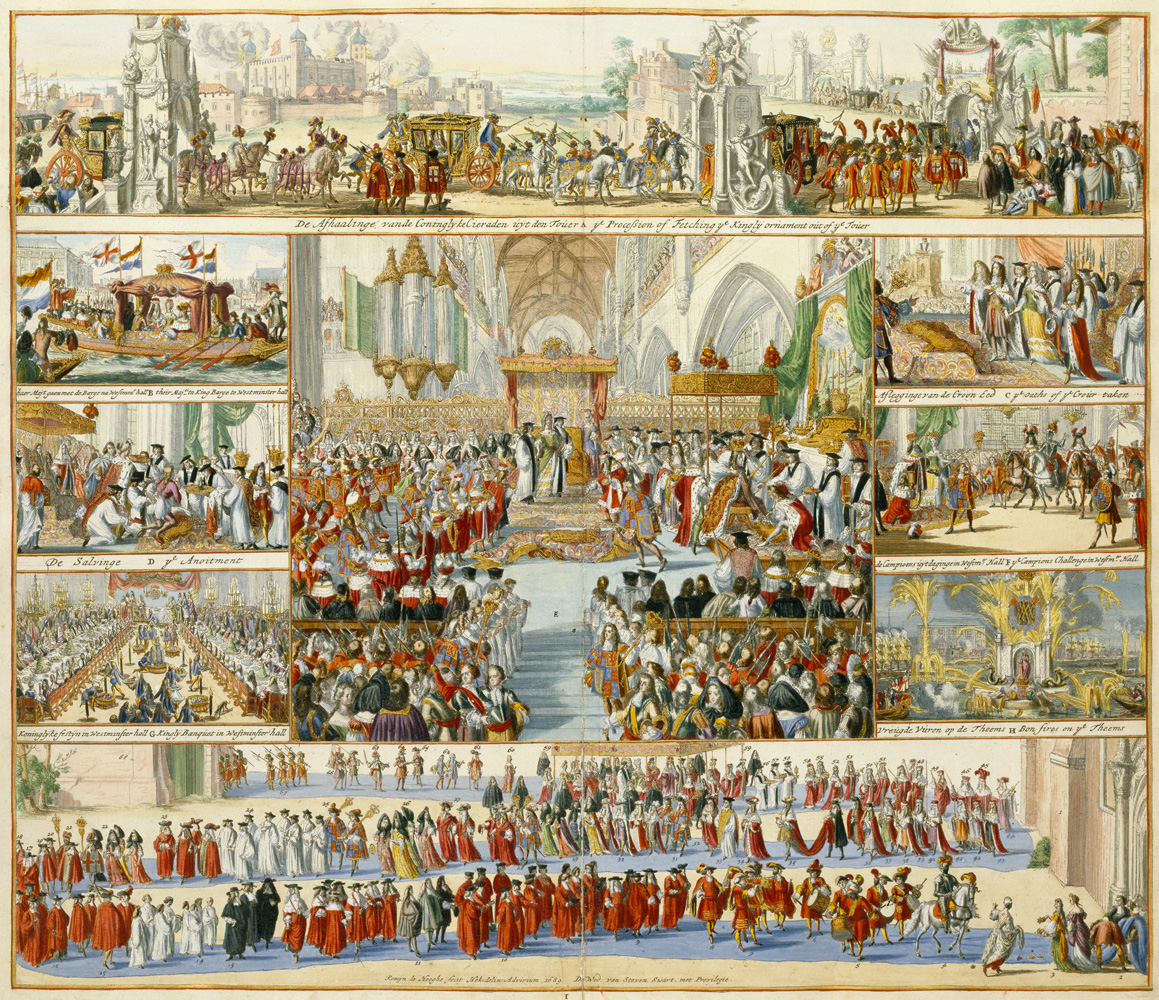Week 2: European Political Culture
Textbook reading: Birn, Chapters 1 & 2. This week we examine the main elements of the social system in post-1648 Europe; the interrelated concepts of the corpus mysticum and the ‘society of orders’; the basics of Europe's economic structure and development during the late seventeenth and early eighteenth centuries; and the principal elements of the pre-industrial demographic regime.
Monarchy
Prepare in advance for discussion in class: The Coronation of Queen Anne, 1702 (Excerpts); also, complete an exercise on the coronation of Queen Anne.I. Discussion: The Coronation of Queen Anne (1702)
Image above: The coronation of Stadholder William III and his wife Mary Stuart as King and Queen of England in 1689 symbolized the end of the Glorious Revolution. Among the retinue accompanying William and Mary to England was the engraver Romeyn de Hooghe (1645-1708), who specialized in etchings that recorded contemporary events. Image source: Koninklijke Bibliotheek, Atlas van der Hagen. Image right: Portrait of Queen Anne. Tinted engraving from an atlas commissoned by Augustus the Strong (Elector of Saxony and King of Poland), 1706-1710. Image source: Wikipedia Commons.II. Fundamental Elements: Monarchy
A. Basic Assumptions
1. The Legitimacy and Popularity of Monarchy
2. The Idea of ‘Sacral Monarchy’
a) Example 1: The Royal Touch, a Cure for Scrofula
b) Example 2: The King’s ‘Two Bodies,’ Material and MysticalImage: William I of Orange, Stadhouder of the Netherlands (1559-1584)
Image: King Henry IV of France Cures Scrofula by the ‘Royal Touch’
Image: Napoleon Visiting the Plague-Stricken at Jaffa (1799)
Image: The Funeral Effigy of King Henry VII (r. 1485-1509)B. Varieties of Monarchy in Europe
1. The West: Toward Unigeniture Hereditary Monarchy
2. Central and Eastern Europe: The Persistence of Elective MonarchyMap: The County of Hohenlohe (1789)
Map: The Growth of the Habsburg Lands (1282-1815)
Map: Europe in 1700
Image: Hans Burgkmair the Elder, Quaternion (1510)III. Fundamental Elements: Representation
A. Representation and the ‘Corpus Mysticum’
1. The Concept of Embodiment in Early Modern Europe
2. Representative Assemblies as ‘Embodiments’
3. Representation as Theater
4. A Case in Point: The French Etats GénérauxIV. Varieties of Political Representation in Europe
Map: The French Pays d’états
Image: A Landsgemeinde in Schwyz, 1763
Image right: The Roasting of the Ox at the Election of Emperor Matthias, 1612. Tinted woodcut. Historisches Museum, Frankfurt.
The people were present in the rituals of European monarchy in many forms and functions. Homage was the most obvious of these rituals, in which a newly crowned ruler pledged to protect his subjects in return for oaths of obedience and service. At their coronations, the German Emperors were also expected to perform various rituals of largesse toward the people of Frankfurt, where coronations always took place. One of the oldest was the tradition of distributing coins to the people on coronation day. Another was the ceremonial ox roast: three days before the coronation, an bull was marched onto the main square in Frankfurt and slaughtered; on the following day, the bull was placed on a giant roasting spit and stuffed with pheasants, calves, snipes, geese, ducks and muttons in such a way that their heads stuck through slits cut in the bull's sides. The roasting bull is said to have given off an horrible stench; nevertheless, the citizens of Frankfurt claimed the bull's meat as their right, and attempts to prevent them from carving off pieces of the roasted ox were met with loud protests, even rioting. Image source: Bernd H. Wanger, Kaiserwahl und Krönung im Frankfurt des 17. Jahrhunderts (Frankfurt, 1994).
.jpg)

.jpg)
.jpg)
.jpg)
.jpg)